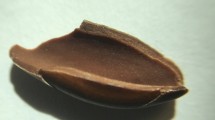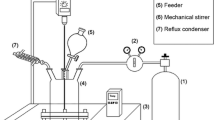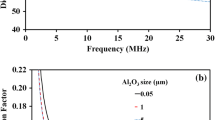Abstract
The present work focuses on thermal, mechanical, and morphological properties of poly(ε-caprolactone) (PCL) on incorporation of granular tapioca starch (GTS). Biocomposites containing 0–35 wt% (Φf = 0–0.36) of the dispersed GTS phase were prepared by melt compounding in a twin screw extruder followed by microinjection molding. From the DSC measurements, sharp decrease in crystallinity was observed for all the compositions studied. The observed marginal decrease in onset degradation temperature suggests that the incorporation of GTS does not compromise thermal stability in PCL/GTS biocomposites. The maximum tensile modulus observed at Φf = 0.36 was 225.8 MPa, while a decrease in tensile yield strength with the value 12.44 MPa was observed. After eliminating the effect of crystallinity, these biocomposites showed ~4 times increase in tensile modulus and ~2 times increase in yield strength, whereas the impact properties decreased by 59 %. The enhancement in Young’s modulus was due to the mechanical restraint created by GTS particles which tend to decrease notched Izod impact strength by enhancing the stiffness of PCL. From SEM micrographs, homogeneous dispersion of GTS particles was observed in PCL matrix. Theoretical models were used to analyze tensile modulus and yield strength data for the estimation of various phase-adhesion parameters.













Similar content being viewed by others
References
Ishiaku U, Pang K, Lee W, Ishak ZM (2002) Mechanical properties and enzymic degradation of thermoplastic and granular sago starch filled poly (ε-caprolactone). Eur Polymer J 38(2):393–401
Avella M, Errico ME, Laurienzo P, Martuscelli E, Raimo M, Rimedio R (2000) Preparation and characterisation of compatibilised polycaprolactone/starch composites. Polymer 41(10):3875–3881
Salgado CL, Sanchez E, Mano J, Moraes A (2012) Characterization of chitosan and polycaprolactone membranes designed for wound repair application. J Mater Sci 47(2):659–667
She H, Xiao X, Liu R (2007) Preparation and characterization of polycaprolactone–chitosan composites for tissue engineering applications. J Mater Sci 42(19):8113–8119
Ciardelli G, Chiono V, Vozzi G, Pracella M, Ahluwalia A, Barbani N, Cristallini C, Giusti P (2005) Blends of poly-(ε-caprolactone) and polysaccharides in tissue engineering applications. Biomacromolecules 6(4):1961–1976
Ma X, Yu J, Zhao A (2006) Properties of biodegradable poly(propylene carbonate)/starch composites with succinic anhydride. Compos Sci Technol 66(13):2360–2366
Yu F, Prashantha K, Soulestin J, Lacrampe M-F, Krawczak P (2013) Plasticized-starch/poly(ethylene oxide) blends prepared by extrusion. Carbohydr Polym 91(1):253–261
Averous L, Moro L, Dole P, Fringant C (2000) Properties of thermoplastic blends: starch–polycaprolactone. Polymer 41(11):4157–4167
Al-Mulla EAJ, Yunus WMZW, Ibrahim NAB, Rahman MZA (2010) Properties of epoxidized palm oil plasticized polytlactic acid. J Mater Sci 45(7):1942–1946
Avérous L, Fringant C (2001) Association between plasticized starch and polyesters: processing and performances of injected biodegradable systems. Polym Eng Sci 41(5):727–734
Sewda K, Maiti SN (2010) Crystallization and melting behavior of HDPE in HDPE/teak wood flour composites and their correlation with mechanical properties. J Appl Polym Sci 118(4):2264–2275
Matzinos P, Tserki V, Gianikouris C, Pavlidou E, Panayiotou C (2002) Processing and characterization of LDPE/starch/PCL blends. Eur Polym J 38(9):1713–1720
Rosa DS, Guedes CGF, Pedroso AG, Calil MR (2004) The influence of starch gelatinization on the rheological, thermal, and morphological properties of poly(ɛ-caprolactone) with corn starch blends. Mater Sci Eng C 24(5):663–670
Rosa DS, Lopes DR, Calil MR (2005) Thermal properties and enzymatic degradation of blends of poly(ε-caprolactone) with starches. Polym Test 24(6):756–761
Pérez CJ, Alvarez VA, Vázquez A (2008) Creep behaviour of layered silicate/starch–polycaprolactone blends nanocomposites. Mater Sci Eng A 480(1–2):259–265
Lee S-H, Ohkita T (2003) Mechanical and thermal flow properties of wood flour–biodegradable polymer composites. J Appl Polym Sci 90(7):1900–1905
Swapna Joseph C, Harish Prashanth KV, Rastogi NK, Indiramma AR, Yella Reddy S, Raghavarao KSMS (2011) Optimum blend of chitosan and poly-(ε-caprolactone) for fabrication of films for food packaging applications. Food Bioprocess Technol 4(7):1179–1185
Sivalingam G, Madras G (2003) Thermal degradation of poly (ε-caprolactone). Polym Degrad Stab 80(1):11–16
Shin BY, Narayan R, Lee SI, Lee TJ (2008) Morphology and rheological properties of blends of chemically modified thermoplastic starch and polycaprolactone. Polym Eng Sci 48(11):2126–2133
Wu C-S (2004) Analysis of mechanical, thermal, and morphological behavior of polycaprolactone/wood flour blends. J Appl Polym Sci 94(3):1000–1006
Valdés García A, Ramos Santonja M, Sanahuja AB, Selva M (2014) Characterization and degradation characteristics of poly(ε-caprolactone)-based composites reinforced with almond skin residues. Polym Degrad Stab 108:269–279
Koenig MF, Huang SJ (1995) Biodegradable blends and composites of polycaprolactone and starch derivatives. Polymer 36(9):1877–1882
Kim EG, Kim BS, Kim DS (2007) Physical properties and morphology of polycaprolactone/starch/pine-leaf composites. J Appl Polym Sci 103(2):928–934
Lu D, Xiao C, Xu S (2009) Starch-based completely biodegradable polymer materials. Express Polym Lett 3(6):366–375
Zhang YP, Lee SH, Reddy KR, Gopalan AI, Lee KP (2007) Synthesis and characterization of core-shell SiO2 nanoparticles/poly (3-aminophenylboronic acid) composites. J Appl Polym Sci 104(4):2743–2750
Reddy KR, Lee K-P, Gopalan AI (2007) Self-assembly directed synthesis of poly (ortho-toluidine)-metal (gold and palladium) composite nanospheres. J Nanosci Nanotechnol 7(9):3117–3125
Mikešová J, Šlouf M, Gohs U, Popelková D, Vacková T, Vu NH, Kratochvíl J, Zhigunov A (2014) Nanocomposites of polypropylene/titanate nanotubes: morphology, nucleation effects of nanoparticles and properties. Polym Bull 71(4):795–818
Choi SH, Kim DH, Raghu AV, Reddy KR, Lee H-I, Yoon KS, Jeong HM, Kim BK (2012) Properties of graphene/waterborne polyurethane nanocomposites cast from colloidal dispersion mixtures. J Macromol Sci Part B 51(1):197–207
Howarter JA, Youngblood JP (2007) Self-cleaning and anti-fog surfaces via stimuli-responsive polymer brushes. Adv Mater 19(22):3838–3843
Lee YR, Kim SC, H-i L, Jeong HM, Raghu AV, Reddy KR, Kim BK (2011) Graphite oxides as effective fire retardants of epoxy resin. Macromol Res 19(1):66–71
Clark PD, Dowling NI, Huang M (2015) Role of Ti3+ in CS2 conversion over TiO2 Claus catalyst. Appl Catal A 489:111–116
Han SJ, Lee H-I, Jeong HM, Kim BK, Raghu AV, Reddy KR (2014) Graphene modified lipophilically by stearic acid and its composite with low density polyethylene. J Macromol Sci Part B 53(7):1193–1204
Reddy KR, Sin BC, Ryu KS, Kim J-C, Chung H, Lee Y (2009) Conducting polymer functionalized multi-walled carbon nanotubes with noble metal nanoparticles: synthesis, morphological characteristics and electrical properties. Synth Met 159(7):595–603
Hassan M, Reddy KR, Haque E, Faisal SN, Ghasemi S, Minett AI, Gomes VG (2014) Hierarchical assembly of graphene/polyaniline nanostructures to synthesize free-standing supercapacitor electrode. Compos Sci Technol 98:1–8
Vertuccio L, Gorrasi G, Sorrentino A, Vittoria V (2009) Nano clay reinforced PCL/starch blends obtained by high energy ball milling. Carbohydr Polym 75(1):172–179
Maran JP, Sivakumar V, Sridhar R, Thirugnanasambandham K (2013) Development of model for barrier and optical properties of tapioca starch based edible films. Carbohydr Polym 92(2):1335–1347
Liu J, Reni L, Wei Q, Wu J, Liu S, Wang Y, Li G (2011) Fabrication and characterization of polycaprolactone/calcium sulfate whisker composites. Express Polym Lett 5(8):742–752
Hu X, Xu H, Zhang Z (1994) Influence of fillers on the effectiveness of stabilizers. Polym Degrad Stab 43(2):225–228
Leong Y, Bakar A, Ishak Z, Ariffin A, Pukanszky B (2004) Comparison of the mechanical properties and interfacial interactions between talc, kaolin, and calcium carbonate filled polypropylene composites. J Appl Polym Sci 91(5):3315–3326
Wang Y, Rodriguez-Perez MA, Reis RL, Mano JF (2005) Thermal and thermomechanical behaviour of polycaprolactone and starch/polycaprolactone blends for biomedical applications. Macromol Mater Eng 290(8):792–801
Cai J, Xiong Z, Zhou M, Tan J, Zeng F, Lin S, Xiong H (2014) Thermal properties and crystallization behavior of thermoplastic starch/poly (ɛ-caprolactone) composites. Carbohydr Polym 102:746–754
Odusanya O, Ishiaku U, Azemi B, Manan B, Kammer H (2000) On mechanical properties of sago starch/poly (ε-caprolactone) composites. Polym Eng Sci 40(6):1298–1305
Mahieu A, Terrié C, Agoulon A, Leblanc N, Youssef B (2013) Thermoplastic starch and poly(ε-caprolactone) blends: morphology and mechanical properties as a function of relative humidity. J Polym Res 20(9):1–13
Ali Akbari Ghavimi S, Ebrahimzadeh MH, Solati-Hashjin M, Osman A, Azuan N (2015) Polycaprolactone/starch composite: fabrication, structure, properties, and applications. J Biomed Mater Res Part A 103(7):2482–2498
Sun Y, Hu Q, Qian J, Li T, Ma P, Shi D, Dong W, Chen M (2016) Preparation and properties of thermoplastic poly (caprolactone) composites containing high amount of esterified starch without plasticizer. Carbohydr Polym 139:28–34
Willett JL (1994) Mechanical properties of LDPE/granular starch composites. J Appl Polym Sci 54(11):1685–1695
Mano J, Koniarova D, Reis R (2003) Thermal properties of thermoplastic starch/synthetic polymer blends with potential biomedical applicability. J Mater Sci Mater Med 14(2):127–135
Ruseckaite RA, Jiménez A (2003) Thermal degradation of mixtures of polycaprolactone with cellulose derivatives. Polym Degrad Stab 81(2):353–358
Marques PT, Lima A, Bianco G, Laurindo J, Borsali R, Le Meins J-F, Soldi V (2006) Thermal properties and stability of cassava starch films cross-linked with tetraethylene glycol diacrylate. Polym Degrad Stab 91(4):726–732
Petinakis E, Liu X, Yu L, Way C, Sangwan P, Dean K, Bateman S, Edward G (2010) Biodegradation and thermal decomposition of poly (lactic acid)-based materials reinforced by hydrophilic fillers. Polym Degrad Stab 95(9):1704–1707
Brydson JA (1999) Plastics materials. Butterworth-Heinemann, London
Tomar N, Maiti SN (2010) Mechanical properties of mica-filled PBT/ABAS composites. J Appl Polym Sci 117(2):672–681
Campos A, Tonoli GD, Marconcini J, Mattoso LC, Klamczynski A, Gregorski K, Wood D, Williams T, Chiou B-S, Imam S (2013) TPS/PCL composite reinforced with treated sisal fibers: property, biodegradation and water-absorption. J Polym Environ 21(1):1–7
Sewda K, Maiti S (2007) Mechanical properties of HDPE/bark flour composites. J Appl Polym Sci 105(5):2598–2604
Pukanszky B (1990) Influence of interface interaction on the ultimate tensile properties of polymer composites. Composites 21(3):255–262
Pukanszky B, Belina K, Rockenbauer A, Maurer F (1994) Effect of nucleation, filler anisotropy and orientation on the properties of PP composites. Composites 25(3):205–214
Móczó J, Pukánszky B (2008) Polymer micro and nanocomposites: structure, interactions, properties. J Ind Eng Chem 14(5):535–563
Balamurugan GP, Maiti SN (2010) Effects of nanotalc inclusion on mechanical, microstructural, melt shear rheological, and crystallization behavior of polyamide 6-based binary and ternary nanocomposites. Polym Eng Sci 50(10):1978–1993
Sewda K, Maiti S (2009) Mechanical properties of teak wood flour-reinforced HDPE composites. J Appl Polym Sci 112(3):1826–1834
Acknowledgments
The authors would like to acknowledge the Indian Institute of Technology Delhi and Ministry of Human Resource Development for providing research facilities and financial assistance to one of the author (Achla).
Author information
Authors and Affiliations
Corresponding author
Rights and permissions
About this article
Cite this article
Achla, Maiti, S.N. & Jacob, J. Analytical interpretation of mechanical response of green biocomposites based on poly(ε-caprolactone) and granular tapioca starch. Polym. Bull. 74, 1693–1711 (2017). https://doi.org/10.1007/s00289-016-1797-x
Received:
Revised:
Accepted:
Published:
Issue Date:
DOI: https://doi.org/10.1007/s00289-016-1797-x




